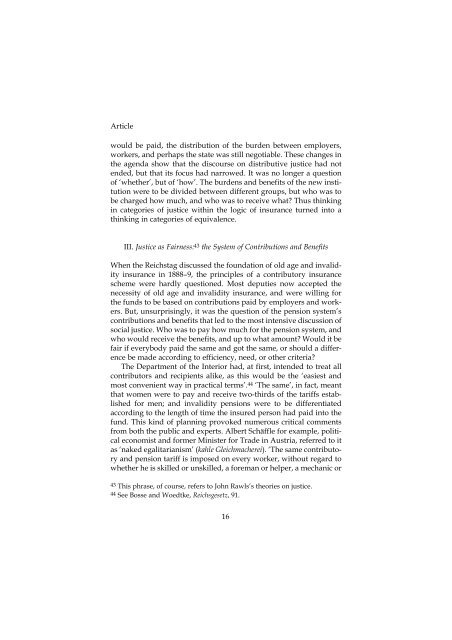Download - German Historical Institute London
Download - German Historical Institute London
Download - German Historical Institute London
Create successful ePaper yourself
Turn your PDF publications into a flip-book with our unique Google optimized e-Paper software.
Article<br />
would be paid, the distribution of the burden between employers,<br />
workers, and perhaps the state was still negotiable. These changes in<br />
the agenda show that the discourse on distributive justice had not<br />
ended, but that its focus had narrowed. It was no longer a question<br />
of ‘whether’, but of ‘how’. The burdens and benefits of the new institution<br />
were to be divided between different groups, but who was to<br />
be charged how much, and who was to receive what? Thus thinking<br />
in categories of justice within the logic of insurance turned into a<br />
thinking in categories of equivalence.<br />
III. Justice as Fairness: 43 the System of Contributions and Benefits<br />
When the Reichstag discussed the foundation of old age and invalidity<br />
insurance in 1888–9, the principles of a contributory insurance<br />
scheme were hardly questioned. Most deputies now accepted the<br />
necessity of old age and invalidity insurance, and were willing for<br />
the funds to be based on contributions paid by employers and workers.<br />
But, unsurprisingly, it was the question of the pension system’s<br />
contributions and benefits that led to the most intensive discussion of<br />
social justice. Who was to pay how much for the pension system, and<br />
who would receive the benefits, and up to what amount? Would it be<br />
fair if everybody paid the same and got the same, or should a difference<br />
be made according to efficiency, need, or other criteria?<br />
The Department of the Interior had, at first, intended to treat all<br />
contributors and recipients alike, as this would be the ‘easiest and<br />
most convenient way in practical terms’. 44 ‘The same’, in fact, meant<br />
that women were to pay and receive two-thirds of the tariffs established<br />
for men; and invalidity pensions were to be differentiated<br />
according to the length of time the insured person had paid into the<br />
fund. This kind of planning provoked numerous critical comments<br />
from both the public and experts. Albert Schäffle for example, political<br />
economist and former Minister for Trade in Austria, referred to it<br />
as ‘naked egalitarianism’ (kahle Gleichmacherei). ‘The same contributory<br />
and pension tariff is imposed on every worker, without regard to<br />
whether he is skilled or unskilled, a foreman or helper, a mechanic or<br />
43 This phrase, of course, refers to John Rawls’s theories on justice.<br />
44 See Bosse and Woedtke, Reichsgesetz, 91.<br />
16













